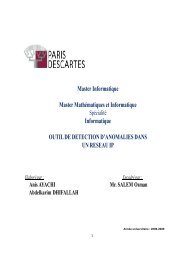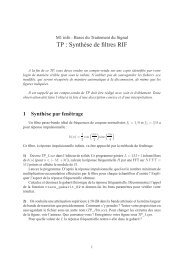Th`ese de Doctorat de l'université Paris VI Pierre et Marie Curie Mlle ...
Th`ese de Doctorat de l'université Paris VI Pierre et Marie Curie Mlle ...
Th`ese de Doctorat de l'université Paris VI Pierre et Marie Curie Mlle ...
You also want an ePaper? Increase the reach of your titles
YUMPU automatically turns print PDFs into web optimized ePapers that Google loves.
static allocation is evi<strong>de</strong>nt both in terms of accepted load and n<strong>et</strong>work revenue. More<br />
specifically, OBA achieves the best performance in terms of n<strong>et</strong>work revenue especially for<br />
high offered loads; note that IDBA achieves almost the same performance as SDBA for<br />
medium offered loads.<br />
7.2.2 Simple Core N<strong>et</strong>work Scenario<br />
A more realistic scenario is shown in Figure 7.14. It comprises 6 no<strong>de</strong>s and 8 bidirectional<br />
links, all having a capacity equal to 2 Mb/s and propagation <strong>de</strong>lay of 1 ms. In this topology,<br />
6 Exponential On-Off traffic sources are consi<strong>de</strong>red, and their source and <strong>de</strong>stination no<strong>de</strong>s<br />
are indicated in the Figure. Table 7.1 reports the peak rate, the subscribed rate, the utility<br />
function and the path for all the connections. Sources S1, S2 and S3 are associated the<br />
utility function 0.5·log(1+x) while the remaining sources are associated the utility function<br />
1.5 · log(1 + x). All other param<strong>et</strong>ers are s<strong>et</strong> as in the previous scenarios. Note that,<br />
with such paths choice, various connections comp<strong>et</strong>e for n<strong>et</strong>work capacity with different<br />
connections on different links.<br />
In this scenario, the performance of IDBA almost overlaps that of OBA. This is expected<br />
because the number of connections entering the n<strong>et</strong>work (i.e. 6) is quite small to gauge<br />
the potential of OBA. Further, all the proposed algorithms (SDBA, IDBA and OBA)<br />
outperform static allocation, as shown in Figures 7.15 and 7.16, thus proving the benefit<br />
of the proposed schemes. These results verify that our allocation algorithms allow service<br />
provi<strong>de</strong>rs to increase n<strong>et</strong>work capacity utilization and consequently n<strong>et</strong>work extra-revenue<br />
with respect to static provisioning techniques.<br />
7.2.3 Multi-Bottleneck Scenario<br />
We then consi<strong>de</strong>r the n<strong>et</strong>work topology shown in Figure 7.17, originally proposed in [1].<br />
It comprises 8 core no<strong>de</strong>s and 7 bidirectional links, all having the same propagation <strong>de</strong>lay,<br />
66










